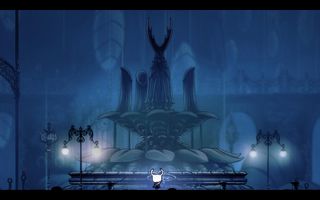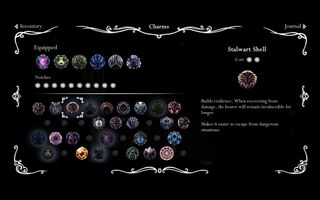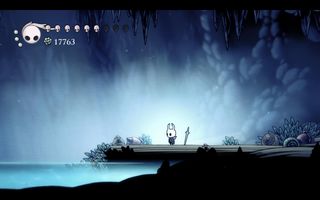Our Verdict
Hollow Knight is a new classic, with a dense and detailed world full of secrets to discover.
PC Gamer's got your back
What is it? A hand drawn Metroidvania in a dark but adorable bug world.
Expect to pay: $15/£11
Developer: Team Cherry
Publisher: Team Cherry
Reviewed on: Windows 10, 8GB RAM, GeForce GTX 970
Multiplayer: None
Link: Official site
Buy: Humble Store
I'm in the middle of exploring a lush, green cavern called the Queen's Garden when the ground gives way beneath my feet. Instead of hitting spikes and resetting back to safety to try again, I just keep falling downward. The leafy walls rush past, becoming dark rock and then web covered crags. If I had found the double-jump ability by this point in Hollow Knight, I could hop up to an exit path and continue exploring in the relative safety of the Garden. But I haven’t, so I can’t. Instead, I have to fight my way through a spider-filled hell for two hours. Hallownest is an unforgiving place.
It's also ridiculously huge. Hollow Knight is a 2D action-platformer in the Metroidvania style, meaning it's centered around exploring an open map, hunting for secrets, and finding abilities that let you reach previously inaccessible areas. What makes it stand out, above all else, is how expansive and detailed the dense subterranean kingdom of Hallownest is. The uniquely-themed areas interlock with a consistent logic that only reveals itself through exploration—everything is built on that kingdom's fading history, the details of which are never explained outright, instead living in the crumbling architecture and a few folk left still living there. Its world design alone puts it at the top of the genre.
Hollow Knight actually came out back in February and we didn't review it at the time, which is a mistake I'm happy to correct. After nearly 35 hours of exploring Hallownest to reach 100% completion, I can assure you it will never be too late to go back and play this wonderful game.

Hollow ground
You enter Hollow Knight's world long past its prime—a dying kingdom, its society torn to pieces and its heroes already fallen. There's nothing but a desolate and dark landscape on the surface and a winding catacomb filled with the stink of death below. You control an emotionless knight, your purpose not entirely clear at the outset, and delve into that land to ward off the evil within.
Except you're really an adorable little bug-man, fighting and befriending other adorable bug-people. While Hollow Knight is set in what is ostensibly a medieval fantasy kingdom, it's got a buggy carapace stretched over everything. The devastation and loss in Hallownest's history is palpable, but the cute art style means the tone never feels overbearing or depressing. The heavy themes have a light-heartedness about them without slipping into parody.
The NPCs I meet are all quirky and cartoonish, but still feel like coherent parts of the world. A few of my favorites include a pudgy shopkeeper who can't stop giggling, a kindly wandering swordsman who has lost his memory, and the tiny but boisterous Zote the Mighty—who, later in the game, will explain to you all of his 57 precepts if you care to listen that long. These characters bring sparks of life to the otherwise dying caves, many of them reappearing at fixed points around the map, and sometimes even during boss fights to provide a few of Hollow Knight’s most thrilling moments.
They also help unravel Hollow Knight's story bit by bit, which is hard to fully piece together even after completing the game. There's a history to this world that has been partly lost to time. But Hollow Knight does an excellent job of slowly showing me the dots and then stepping back to let me draw the lines between them. Like many of the boss fights and whole areas of the map, engagement with that story is optional. Large parts of it aren't even explained verbally, told only through visual clues in the environment itself.
And good God are those environments pretty. The art in Hollow Knight is stunning, and never dull despite its muted color palette. The characters, backgrounds, and even particle effects are all hand drawn, blended beautifully with subtle lighting effects. Each area of the map feels distinct and interesting, with its own color scheme, sullen but energetic theme music, and visual details scattered about. I love swinging my nail (the world's cone-shaped swords) as I walk, kicking up particles from destructible objects along the way, each unique to the setting around them. And the sound design and score are exceptional, pairing each area with an orchestral soundtrack that perfectly sets the mood as you dive deeper into Hallownest.
The satisfying crack that accompanies chopping down lampposts in the Forgotten Crossroads or cutting grass in Greenpath extends into the combat as well. The fighting is fairly simple: I mostly dance around enemies, trying to slash in with my nail while dodging their attacks. But the hits feel chunky and real, bouncing me back a little every time I connect. Likewise, when an enemy lands a hit on me, I feel it. The game pauses for a split second as a crack flashes over my character before I go flying back. Those hits hurt, even if healing is as simple as finding a safe moment and channeling a resource called Soul to fill myself back up.
Missing attacks or taking hits only ever felt like my own fault, and I could see myself getting better and stronger through practice alone, not only via the damage and speed upgrades I eventually found. Learning how many hits each enemy takes is key to beating them, and most opponents can counter or block, making button mashing fruitless.
But Hollow Knight's combat never did much to surprise me over the course of the game. You fight with the same weapon and essentially the same moveset the entire time—while attack patterns, strategies, and stats will change, nearly every enemy is defeated with a similar dodge-swing-dodge-swing rhythm. Late-game enemies sometimes have more elaborate attacks, but variety comes more from navigating the levels and the brilliant charm system.
Charming
Discovering and customizing my character with charms gave me thoughtful decisions to make throughout my entire 35-hour playthrough. Charms imbue the player with special abilities, but you only have a limited number of 'notches' in which to equip them. They can do simple things such as increase the amount of Soul you get from hitting enemies or improve your attack range, as well as apply more complex modifications such as doubling your health but preventing you from healing or giving you a ranged attack while at full health. The stronger the effect they have, the more notches they take.

What's so impressive about these charms is that I could never find a ‘right’ answer when equipping them. There were no wrong choices. It took me nearly 30 hours to find a build I could consider my goto loadout, and even then I changed things up fairly often. Of course I have favorites—I prefer using the range and attack speed increasing charms most of the time—but it never feels like those are strictly required over others.
Likewise, beating difficult bosses is often a process of finding a new charm combination to give me an edge. Certain bosses need that extra range, while I prioritize extra health for others. At one point I bested a particularly fast boss by equipping all my charms that did indirect damage—one that emits a poison cloud, another that strikes back when I take damage, and so on. It's not a build that was particularly strong for general use, but it was exactly what I needed against that specific enemy. Even outside of bosses, I have a set of charms for when I need to collect money, a set for when I want to move fast, and a set for exploring uncharted territory.
The charms come alongside permanent ability unlocks, most of which are movement abilities including a dash, a double jump, and wall climbing. There are a few optional combat abilities such as a sword spin, but I rarely use them due to the long charge-up time they require. Even if Hollow Knight's combat basics didn't change much as I played, my approach was constantly evolving as these movement abilities opened up new options—both in the traditional Metroidvania sense of unlocking new paths, but also during fights. A double jump makes larger enemies easier to get around, while a wall climb makes fighting flying enemies a little less stressful. I enjoy how intertwined the platforming and the battling is.

Hidden worlds
It's a good thing Hollow Knight's movement feels so great, because there’s a huge amount of space to traverse. On at least three separate occasions, I said "are you kidding me?" out loud as I stumbled upon yet another unique and detailed area that I had no idea existed. Even after getting a Steam achievement for unlocking all the game's maps, there were more hidden areas to find, each with its own theme, enemies, and history within Hallownest.
Nothing about the world is arbitrary or disjointed. The City of Tears, for example, is an underground metropolis in a cavern that's always raining without any explanation, but exploring the area high above the city reveals a large, serene lake resting in a cave directly overhead. These moments of organic discovery make learning Hallownest's history genuinely exciting, acting as little puzzles that have no bearing on my progress but are still satisfying to solve.
The more effort I put into it, the more Hollow Knight rewarded me with thrilling challenges and beautiful, storied caverns to discover.
A surprising amount of Hollow Knight can be completely missed or ignored. Whole sections of the map are locked behind easy-to-miss destructible walls, and one of its three possible endings can be achieved without even dipping a toe into most of the game's optional areas—my favorite area of which is called the White Palace, where Hollow Knight basically transforms into Super Meat Boy with a long series of increasingly difficult platforming sections through mazes of spinning saw blades.
The sheer amount of stuff to do in Hollow Knight is staggering. At around the five hour mark, the map opens up and I started losing track of all the different things I could be doing—to the point where I began keeping notes on a custom map of my own. It's a bit overwhelming, but it also means there’s almost never a wrong choice in where to go. All I had to do was pick a path (or fall down a spider hole), and suddenly I was in some exciting new area with story to learn and upgrades to unlock.
The more effort I put into it, the more Hollow Knight rewarded me with thrilling challenges and beautiful, storied caverns to discover. I reached 100% completion practically by accident. I just wanted to keep exploring all the mysteries the world had to offer me—and I still managed to completely miss the Mr. Mushroom side quest without knowing it—but others could happily choose to stop sooner and it would still be worth the journey. I overlooked it initially, but 35 hours later I can confidently say Hollow Knight is one of the best games I've played.











Hollow Knight is a new classic, with a dense and detailed world full of secrets to discover.

